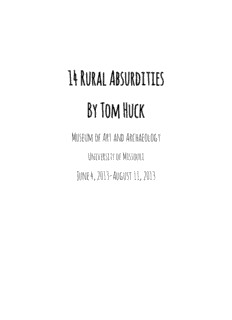
14 Rural Absurdities By Tom Huck PDF
Preview 14 Rural Absurdities By Tom Huck
14 Rural Absurdities By Tom Huck Museum of Art and Archaeology University of Missouri June 4, 2013-August 11, 2013 The series of large woodcut prints forming this exhibition was created by the Missouri artist Tom Huck (American, b. 1971). Taking three years to complete, these prints are based on events that allegedly occurred in the artist’s boyhood hometown of Potosi, about 80 miles southwest of St. Louis. While true stories are at the heart of the prints, the viewer may find these tales as told by Huck hard to believe. Loaded with a remarkable amount of detailed information shown from a variety of artistic viewpoints, the prints are an interesting example of visual storytelling. Using bold black and white lines, Huck weaves complex and dense narrative compositions, which harken back to the masterly woodcuts of Albrecht Dürer (1471-1528), the work of whom Huck studied closely. The level of intricacy and wide range of textures and tonalities in these prints reveal Huck’s mastery of the woodcut medium. In the words of Huck: “Woodcuts are an inherently expressive medium. By that I mean when one carves an image out of wood it fights you. God or whatever didn’t make trees for us to carve images out of, and that struggle shows in the resulting printed image. This is why the German expressionists loved woodcuts so much, for it heightened the emotional content of the work. The quality of the lines is more jagged, and heavy black. Another big reason: DÜRER!” Huck’s art also shows the influence of William Hogarth (1697-1764), a British artist known for his highly detailed prints that took the art of visual satire to a new level of sophistication and complexity. Like Hogarth, Huck incorporates a high level of detail and uses satire ranging from the comedic to the tragic. Huck’s highly detailed characterizations, however, retell ludicrous moments from the history of rural Missouri. Humorous and provocative, Huck’s interpretations poke fun at his subjects while presenting a complex view of the foibles and flaws of people. This is facilitated by the artist’s exaggeration and enrichment of the tales, which distances the characters from the viewer. While the stories and people represented by Huck may seem absurd, they reflect some of the darker and more disturbing aspects of humanity, which Huck brings to life in these remarkable large-scale woodcuts. * The commentaries on the labels detailing the stories of each print were provided by the artist. KOHLER CITY REVISITED, 1991 99.4.1 Gilbreath-McLorn Museum Fund A local store called “Kohler City” sold a wide variety of goods, including little rubber toys, used eye glasses, and used dentures. On one occasion while visiting this establishment with my mother, I saw a couple of old men “trying on” a few items and then putting them back into the piles. CATWALK: HERE THEY COME!, 1999 99.4.2 Gilbreath-McLorn Museum Fund Every summer at the Moses Austin Heritage Festival, a period costume Gala and Fashion Show is held. In its inaugural version, various “local beauties” were recruited to model the outfits. A few local fellows mistook this Gala to be a stripshow. They showed up with the full intention of heckling the models and retrieving certain items of clothing. In the spirit of the event, the models obliged. PLAYLAND: THE GREAT SHARKBURGER SHORTAGE OF ’95, 1999 99.4.3 Gilbreath-McLorn Museum Fund My hometown received its first major fast food chain outlet. On the day of the grand opening, around lunchtime, the line for the drive thru stretched at least two miles. People were waiting for hours just to get a taste of the first burgers churned out by this place. They inevitably ran out, and the resulting mayhem gave new meaning to the word “famine.” THE MARRIAGE OF JIM AND DOLLY, 1999 99.4.4 Gilbreath-McLorn Museum Fund Brotherly and sisterly love, taken to its extreme. MAD DASH FOR CASH, 1999 99.4.5 Gilbreath-McLorn Museum Fund On one of the many occasions I have frequented this yearly event (a crash-up derby), a certain driver who looked just like Jerry Garcia, wearing an early 70’s helmet, crashed into a large rival car. Immediately the car caught aflame, and the emergency technicians removed a smiling, albeit toothless, individual with whom I believe I went to high school. The name of the event was “Mad Dash for Cash,” where the final car left running won $1,000. THE CROSSING GUARD, 1999 99.4.6 Gilbreath-McLorn Museum Fund While a nearby prison prepared a cell for a recently convicted “undesirable,” the decision was made to house this fella in the county jail for a night. He escaped, made his way to the local Catholic church, and stole a few of the priest’s Easter vestments. Our hero then made his way down to the main intersection of town and began directing the morning traffic, occasionally throwing a blessing or two to a few bewildered drivers. EXHUMING MOSES, 1999 99.4.7 Gilbreath-McLorn Museum Fund The founding father of the town, Moses Austin, was buried in a somewhat unprotected grave. His son, Stephen, helped to establish Texas as a state. Many Texans believed that the remains of Moses belonged next to those of Stephen. They came by night, with the intention of exhuming and relocating poor old Moses. Their goal was to smuggle out the remains by chopping the whole body into various sections. Halfway through the unearthing, the men were spotted by an elderly lady who abruptly called the authorities shouting, “They’ve come to steal the carcass of ol’ Moses!” The crime was foiled. HIGH WATER HOG BLUES, 1999 99.4.8 Gilbreath-McLorn Museum Fund During the floods of 1993, I met a hog farmer who spoke of leaving his farm rather hastily when a levee broke. His hogs went to high ground, which in this case was the man’s house. When he returned days later, there were many dead and bloated hogs floating in his living room.
Description: